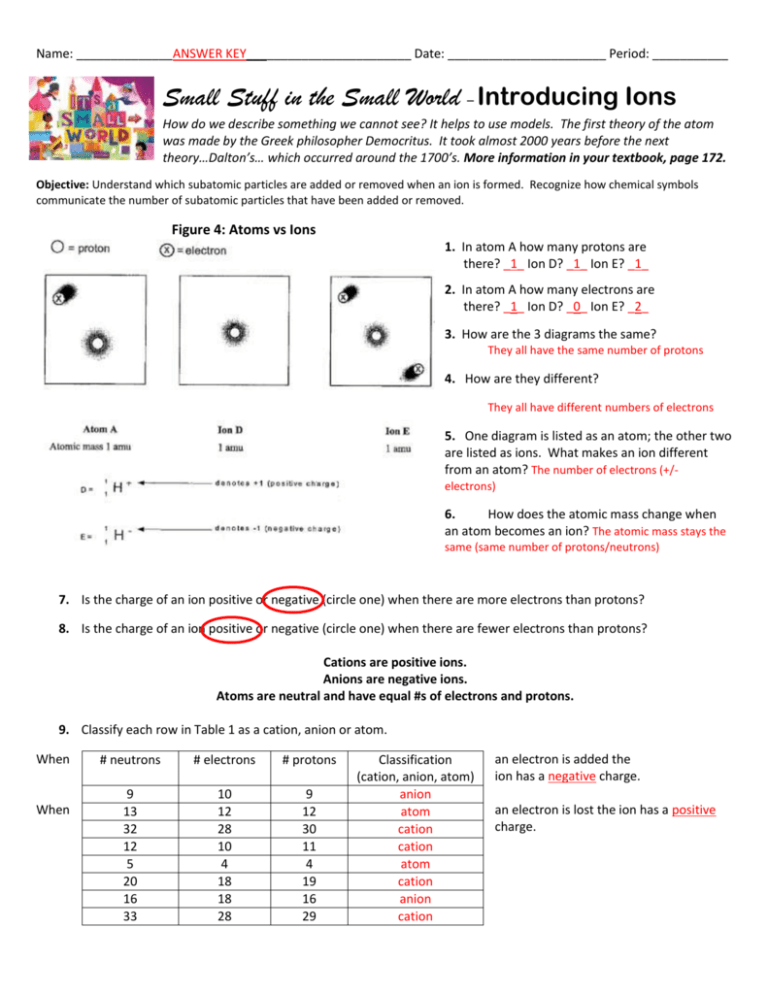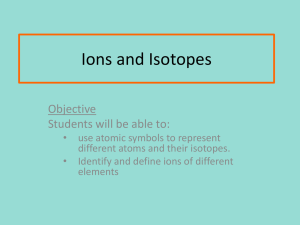Introducing Ions - ANSWER KEY - Liberty Union High School District
advertisement

Name: ______________ANSWER KEY________________________ Date: _______________________ Period: ___________ Small Stuff in the Small World – Introducing Ions How do we describe something we cannot see? It helps to use models. The first theory of the atom was made by the Greek philosopher Democritus. It took almost 2000 years before the next theory…Dalton’s… which occurred around the 1700’s. More information in your textbook, page 172. Objective: Understand which subatomic particles are added or removed when an ion is formed. Recognize how chemical symbols communicate the number of subatomic particles that have been added or removed. Figure 4: Atoms vs Ions 1. In atom A how many protons are there? _1_ Ion D? _1_ Ion E? _1_ 2. In atom A how many electrons are there? _1_ Ion D? _0_ Ion E? _2_ 3. How are the 3 diagrams the same? They all have the same number of protons 4. How are they different? They all have different numbers of electrons 5. One diagram is listed as an atom; the other two are listed as ions. What makes an ion different from an atom? The number of electrons (+/electrons) 6. How does the atomic mass change when an atom becomes an ion? The atomic mass stays the same (same number of protons/neutrons) 7. Is the charge of an ion positive or negative (circle one) when there are more electrons than protons? 8. Is the charge of an ion positive or negative (circle one) when there are fewer electrons than protons? Cations are positive ions. Anions are negative ions. Atoms are neutral and have equal #s of electrons and protons. 9. Classify each row in Table 1 as a cation, anion or atom. When When # neutrons # electrons # protons 9 13 32 12 5 20 16 33 10 12 28 10 4 18 18 28 9 12 30 11 4 19 16 29 Classification (cation, anion, atom) anion atom cation cation atom cation anion cation an electron is added the ion has a negative charge. an electron is lost the ion has a positive charge. Atoms vs. Ions Review The first one, Lithium atom & lithium ion, have been done for you as an example! Cations: Have a positive charge because they have lost electrons Anions: Have a negative charge because they have gained electrons Ion symbol: To write the ion symbol the atomic symbol with the charge written on the top right. Examples: Ca2+, Zn2+, Ag1+ Lithium atom Atomic number: 3 Mass number: 6.941 Protons: 3 Neutrons: 4 Electrons: 3 Cation/Anion: cation Nitrogen atom Atomic number: 7 Mass number: 14 Protons: 7 Neutrons: 7 Electrons: 7 Cation/Anion: Anion Fluorine atom Atomic number: 9 Mass number: 19 Protons: 9 Neutrons: 10 Electrons: 9 Cation/Anion: Anion Lithium ion (+1) Atomic number: 3 Mass number: 6.941 Protons: 3 Neutrons: 4 Electrons: 2 Ion symbol: Li+ Nitrogen ion (-3) Atomic number: 7 Mass number: 14 Protons: 7 Neutrons: 7 Electrons: 10 Ion symbol: N3Fluorine ion (-1) Atomic number: 9 Mass number: 19 Protons: 9 Neutrons: 10 Electrons: 10 Ion symbol: F- Aluminum atom Atomic number: 13 Mass number: 27 Protons: 13 Neutrons: 14 Electrons: 13 Cation/Anion: Cation Sulfur atom Atomic number: 16 Mass number: 32 Protons: 16 Neutrons: 16 Electrons: 16 Cation/Anion: Anion Calcium atom Atomic number: 20 Mass number: 40 Protons: 20 Neutrons: 20 Electrons: 20 Cation/Anion: Cation Aluminum ion (+3) Atomic number: 13 Mass number: 27 Protons: 13 Neutrons: 14 Electrons: 10 Ion symbol: Al3+ Sulfur ion (-2) Atomic number: 16 Mass number: 32 Protons: 16 Neutrons: 16 Electrons: 18 Ion symbol: S2Calcium ion (+2) Atomic number: 20 Mass number: 40 Protons: 20 Neutrons: 20 Electrons: 18 Ion symbol: Ca+2 The charge on an ion will involve a number and a sign. The number will always be the number of electrons involved, e.g., loss of two electrons is +2. The sign will be positive if electrons, negatives, are lost and negative if electrons, negatives, are gained. Determine the charges on the following using the diagram above as a guide: 1. An atom having lost two electrons +2 2. An atom having gained one electron 5. An atom having lost six electrons -1 +6 6. An atom having gained three electrons 3. An atom having lost five electrons +5 7. An atom having gained two electrons 4. An atom having lost one electron +1 8. An atom having gained four electrons -3 -2 -4 For the questions below determine if the particle that is described in an atom or an ion. In the space that says, “charge”, write either “positive”, “negative”, or “no charge”. Then indicate whether the particle is an “atom” or an “ion”. 9. A particle of oxygen that contains 8 protons and 8 electrons. Charge __0___ Atom or ion? atom 10. A particle of fluorine that contains 9 protons and 10 electrons. Charge __-1__ Atom or ion? _ion__ 11. A particle of calcium that contains 20 protons and 18 electrons. Charge __+2__ Atom or ion? _ion_ 12. A particle of uranium that contains 92 protons and 88 electrons. Charge _+4___ Atom or ion? _ion__







